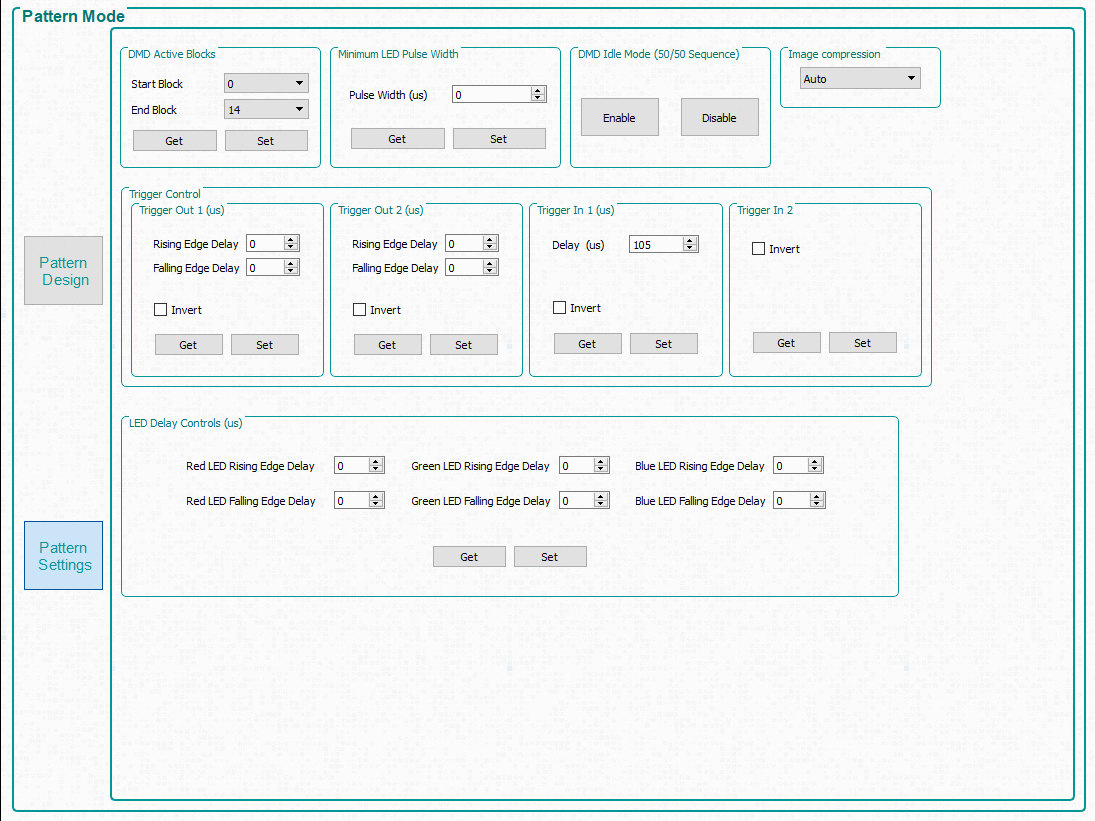DLPU101C december 2020 – may 2023 DLPC900
- 1
- 1 Trademarks
- Read This First
- 2 About This Guide
- 3 Related Documentation from Texas Instruments
- 4 If You Need Assistance
- 5 DLP LightCrafter Single DLPC900 EVM Overview
- 6 Quick Start
-
7 Operating the
DLP LightCrafter Single DLPC900 EVM
- 7.1 DLP LightCrafter Single DLPC900 Control Software
- 7.2 PC Software
- 7.3 System Common Controls
- 7.4 System Settings
- 7.5 Video Mode
- 7.6
Pattern Modes
- 7.6.1 Menu Bar
- 7.6.2 Creating a Pattern Sequence in Pattern On-The-Fly Mode
- 7.6.3 Creating a Pattern Sequence in Pre-Stored Pattern Mode
- 7.6.4 Reordering a Pattern Sequence using the Edit LUT Feature
- 7.6.5 Creating a Pattern Sequence in Video Pattern Mode
- 7.6.6 Creating a Pattern Sequence With DMD Block Load
- 7.6.7 Pattern Settings
- 7.7 Batch Files
- 7.8 Peripherals
- 7.9 Firmware
- 7.10 Flash Device Parameters
- 7.11 JTAG Flash Programming
- 7.12 Programming an EDID
- 8 Connectors
- 9 Power Supply Requirements
- 10Safety
- 11Revision History
7.6.7 Pattern Settings
To configure the output or input triggers click the Pattern Settings button as shown in Figure 7-16. Within this panel, the user can select the output delays of Trigger 1 and 2 and the input delay for Trigger In 1 and 2. The output delays are from the start of the pattern on the DMD.
Trigger In 1 and 2 can be delayed to have a later affect from when the external device performed the trigger. All signals can be inverted.
The LED controls can also be delayed. These delays are from the start of the pattern on the DMD.
Minimum LED Pulse Width control allows the system to have much higher pattern speeds. Input the minimum LED Pulse Width specific to your illumination system to achieve higher pattern speeds through illumination modulation. Illumination modulation occurs with 8-bit patterns at rates faster than 1031 Hz, by modulating the light source to shorten the shortest bits, therefore increasing the maximum pattern speed. The LED enable signals from the DLPC900 can be used to control the illumination modulation of the LEDs.
The DMD Active Blocks allows a subset of DMD blocks to be activated, while the mirrors in the non-selected blocks are set to the off state. See Section 7.6.6 for an example of using this mode. When operating with a subset of DMD blocks, enable the DMD Idle Mode as often as possible. For example, whenever the system is idle, between exposures if the application allows for it, or when the exposure pattern sequence is stopped. To enable the DMD Idle Mode, the pattern sequence must be stopped. To restart the pattern sequence, the DMD Idle Mode must be disabled.
The DMD Idle Mode provides a 50/50 duty cycle across the entire DMD mirror array, where the mirrors are flipped between the on and off states to optimize the performance of the mirrors.
The Image Compression option allows for control of the compression type that occurs to the pattern images.
- The Uncompressed option does not attempt to compress the images.
- The Run Length Encoding (RLE) option is a lossless compression method that compresses the pattern data using horizontal pixel similarities.
- The Enhanced RLE option is a lossless compression method that compresses the pattern data using vertical and horizontal pixel similarities.
- The Auto option is capable of doing all three compression types and selects the method that takes up the smallest amount of data.
More information on these compression types can be found in the DLPC900 Programmer's Guide.
 Figure 7-16 Pattern
Settings Panel
Figure 7-16 Pattern
Settings Panel